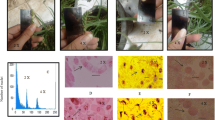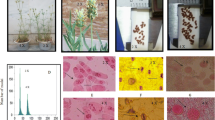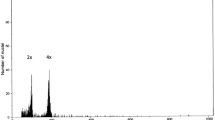Abstract
The present paper concerns a morphological and cytological comparison between the naturally occurring diploid and the colchicine induced tetraploid ofTorenia fournieri Lind.
Treatment of growing points of young seedlings with 0.20% aqueous colchicine for 10 hours on two successive days was most effective in inducing tetraploidy. The induced tetraploids showed the usual “gigas” characters associated with autotetraploidy. There was a significant reduction in pollen fertility and seed setting of tetraploids as compared to their diploid progenitors.
The chromosome numbers of the diploids and the induced tetraploids were determined as n=9 and n=18, respectively. The diploids showed normal meiosis whereas tetraploids were characterized by a high frequency of unequal distribution of chromosomes at anaphase. The induced tetraploids possessed larger flowers. The variability in flower size of the tetraploids offers a good scope for evolving a better horticultural variety of this species.
Similar content being viewed by others
References
Bailey, L. H. (1950).Manual of cultivated plants. MacMillan Co., New York.
Bali, P. N. &S. L. Tandon (1956). Colchicine induced polyploidy in relation to floriculture.Indian J. Hort. 13: 149–157.
Bali, P. N. &S. L. Tandon (1957). Morphological and cytological studies of the diploid and the colchicine induced autotetraploid inIberis amara L.Phyton 9: 107–116.
Bali, P. N. &S. L. Tandon (1959a). Morphological and cytological studies of the diploid and the colchicine induced tetraploid inIberis umbellata L.Phyton 12: 139–146.
Bali, P. N. &S. L. Tandon (1959b). Morphological and cytological studies of the induced polyploids inAlyssum maritimum Lam.Genetica 30: 129–139.
Bhaduri, P. N. &P. N. Ghosh (1954). Chromosome squashes in cereals.Stain Tech. 29: 269–276.
Chandler, C. (1956). Induced Polyploidy in horticultural varieties of Verbena.Contrib. Boyce Thompson Inst. 18: 243–252.
Darlington, C. D. &A. P. Wylie (1955).Chromosome Atlas of Flowering Plants. George Allen and Unwin Ltd., London.
Newcomer, E. H. (1941). A colchicine induced tetraploidCosmos.J. Hered. 32: 161–164.
Stewart, R. N. (1951). Colchicine induced tetraploids in carnations and poinsettias.Proc. Amer. Soc. Hort. Sci. 57: 408–410.
Tandon, S. L. (1950). Colchicine induced polyploidy in spinach.Curr. Sci.,19: 66.
Tandon, S. L. &P. N. Bali (1957). Morphological and cytological studies of the diploid and the colchicine induced tetraploid inLinaria vulgaris.Genetica 29: 101–109.
Author information
Authors and Affiliations
Rights and permissions
About this article
Cite this article
Tandon, S.L., Bhutani, K. Morphological and cytological studies of colchicine-induced tetraploids inTorenia fournieri lind. Genetica 36, 439–445 (1965). https://doi.org/10.1007/BF01557175
Received:
Issue Date:
DOI: https://doi.org/10.1007/BF01557175




